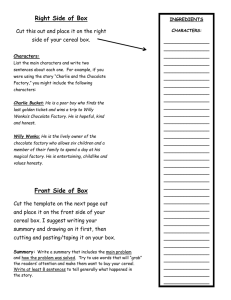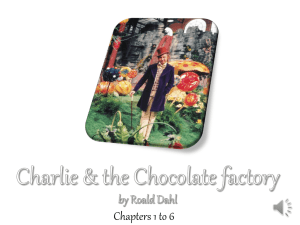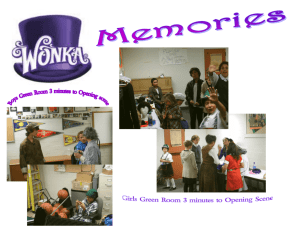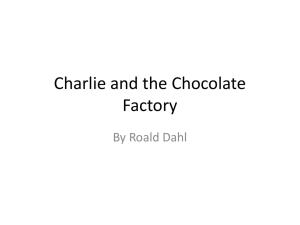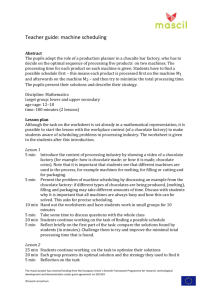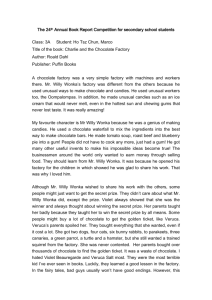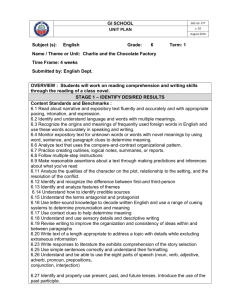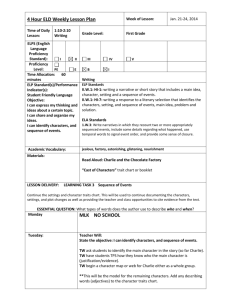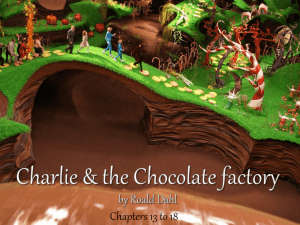Before during and after reading activities
advertisement
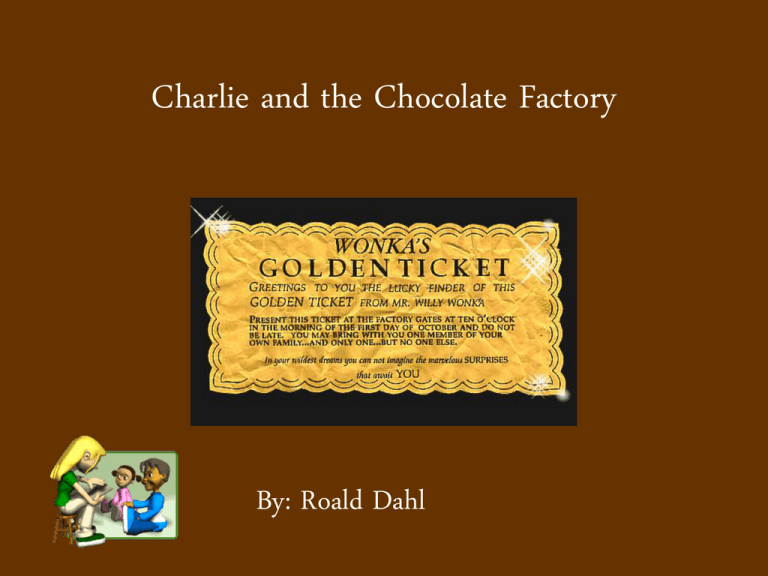
Charlie and the Chocolate Factory By: Roald Dahl Special Education Social Skills Primary Level Character Traits Honest Light-hearted Leader Expert Brave Conceited Mischievous Demanding Thoughtful Keen Bright Courageous Serious Funny Humorous Sad Poor Rich Tall Dark Humble Friendly Short Adventurous Hard-working Timid Shy Bold Daring Dainty Happy Disagreeable Simple Smart Impulsive Fancy Plain Excited Studious Inventive Creative Thrilling Independent Intelligent Compassionate Gentle Proud Wild Messy Neat Joyful Strong Loyal Light Handsome Pretty Ugly Selfish Unselfish Self-confident Respectful Considerate Imaginative Busy Patriotic Fun-loving Popular Successful Responsible Lazy Energetic Dreamer Helpful Simple-minded Pitiful Cooperative Lovable Prim Proper Ambitious Able Quiet Curious Reserved Pleasing Bossy Witty Fighter Tireless Cast of Characters Willy Wonka Violet Beauregarde Mike Teavee Grandpa Joe Charlie Bucket Augustus Gloop Veruca Salt Sweet Traits Sour Traits Warm Up! Please reduce the following fractions: 2/4 3/16 1/2 4/4 8/9 Fun Facts In 1995, Mars Company asked America to choose a new color to add to the bunch. What was the color chosen? You Guessed It! M&M’s Count & Crunch M & M’s Count and Crunch 1. How many M&M’s are in your package? 2. What is the most common color? 3. What is the least common color? 4. What is the class favorite color? 5. What is the overall favorite color? M&M’s Count & Crunch Prediction Actual Green Orange Yellow Blue Dk Brown Lt Brown Red # # Group 1 Group 2 Group 3 Group 4 Group 5 Group 6 Group 7 Group 8 Group 9 Group 10 Group 11 Group 12 Group 13 Group 14 Group 15 Ratio Ratio # Ratio # Ratio # Ratio # Ratio # Ratio Group 1 Group 2 Group 3 Group 4 Group 5 Group 6 Group 7 Group 8 Group 9 Group 10 Group 11 Group 12 Group 13 Group 14 Group 15 Green Orange Yellow # # # % % % Blue # Dk Brown % # % Lt Brown # % Red # % Writing Activities by Amanda Bearden Research the candy-making process through a Webquest Write a feature article on the process that they have discovered Create candy, wrapper, and jingle Write a prediction, based on the cover of the book, about the story Develop a book talk to present the book to the students and possibly the parents. (This would be great to have at a family reading night and invite parents to come.) • Write a poem or song in the style of the Oompa Loompa’s songs from the story. • Keep a vocabulary journal of new words learned throughout the story. • Use a graphic organizer to plot the story elements as the story progresses. • Develop a tri-a-rama based a particular setting in the story. • Interview a character in the story. Students will be put into pairs in which one student is a reporter and the other a character from the story. Together they prepare 8-10 questions for the interviewer to ask. • Create a Venn diagram comparing the movie and the book. • Compose a new ending for the story. • Design a book jacket Social Studies Connection by: Kimberly Staton K – 2nd The Family Cookbook Family Tree: Students interview family members and create a family tree using pictures that students may glue to a construction paper tree and laminate for display. Class Cookbook: When interviewing family members for the family tree, students will collect favorite family chocolate recipes. The class will work together to assemble a Chocolate recipe book to give as gifts to their families. 3rd – 5th A Willy Wonka Board Game After reading the book and watching the movie, students will research factories on the internet. Students will use this information to make a Willy Wonka board game. The board game will resemble the chocolate factory. Game cards and rules will be based on the guidelines of running a factory to produce goods. 5th – 12th Poverty and Food in America Students will research poverty in America today and during the depression. Students will be divided into groups. Each group will be given a description of a young person living in poverty. Groups will have to write a schedule of what a typical day might be for that person living in poverty. Each group will present their scenario and the class will come up with solutions to overcoming hunger in America. 5th – 12th Poverty and Housing in America Students will examine and discuss the housing conditions that Charlie and many other people were living in during the depression. Students will research in two groups the housing problems faced in America today and conduct a classroom debate. 5th – 12th Poverty and Employment in America Students will research the problems surrounding employment in America. Students will participate in a round table discussion and create long term solutions to the following problems: unemployment loss of public service loss of personal assets Graphic Organizers Middle School SDI Vocabulary Sort into Parts of Speech Character Map Story Map Reading Strategies for Primary Reading Before Reading • Predict what the story might be about just by hearing the title; looking at the cover. • Discuss other books by Roald Dahl. • Ask questions such as: Would you ever enter a contest? Would you spend money you found in the street? Would you do something you were told not to do? • Work in groups to write a story about a poor family that wins a contest. • Research chocolate and how it is made. Ask students who have visited a candy factory to share their experiences with the class. Have students imagine what they think the inside of a chocolate factory looks like. Let them illustrate it. • Do a KWL chart about chocolate factories. • Pre-read the first chapter and create a vocabulary list they need before they begin to read. During Reading • Have students read the first chapter while jotting down any unknown words on post-its. • Take the unknown words and place them on the board as a vocabulary list. Have students work together in groups to use the four-block method of writing the word, defining it, drawing it, and using the word in a sentence. • Formulate guided reading questions for each days reading lesson. • Because the book is above primary level, have students practice the book with many strategies such as guided reading, choral and echo reading, partner reading, and even hearing a chapter read from a tape. • Do character maps while reading. Jot down as much information while you are reading about any one character. Then have students complete a character map on one they choose. • Use many graphic organizers to help aide reading such as the KWL chart, text studies. T-charts, flow charts, or guided reading question charts. Anything to have students reading for a purpose. • Keep a reading journal full of ideas and thoughts about the book, or any questions you have, or words you don’t know. After Reading Strategies • One minute papers: students write about the most important information they learned from the day’s reading. • Fill in the KWL chart, or other graphic organizer. • Have students write the main idea of the day’s reading, and at least 3 details. • Answer the 5 W’s: Who, What, When Where and How? • Do a Character Trait Planner, choosing Charlie or another main character. • Complete a Story Map. • Do a story Pyramid using 5 lines such as: Line 1: a word that describes the main character or title Line 2: two words to describe the main character Line 3: three words to describe the setting Line 4: four words to describe the main idea of the story Line 5: five words to tell a main event in the story. More After Reading Strategies Perform a Reader’s Theatre for one of the chapters or a group of the chapters. Put on a play. Sequence activities such as using strips or story pictures. Do one of a thousand writing activities such as such as creative writing topics or Story frames. Write a summary. Have a book party where students dress up as characters, eat foods from the book, decorate the room as a setting from the story. Create a class cookbook of chocolate recipes that go along with the story. Have students create their own invention like the ones in the story. Place them in the hall for others to see. Charlie and the Chocolate Factory 8th Grade Unit Before, During and After Reading Activities Before Reading Activity Students will create a “foldable” with the following tabs: Heading: Parts of a Story 1st Fold: Title. The name of a story. 2nd Fold: Author. The person who wrote the story. 3rd Fold: Illustrator. The person who creates the pictures for the story. 4th Fold: Setting. The time, the place and the environment in which the story takes place. It sets the scene for the events in the story. 5th Fold: Characters. May be people, animals or things. The story centers around the main character or characters. 6th Fold: Plot The series of events that take place in the story. The plot usually centers around the problem and how the characters solve that problem. The plot is usually in 3 parts: Beginning This part of the story introduces the setting, the characters and the problem. Middle This part of the story tells how the characters react to the problem. End This part of the story usually solves the problem. During Reading Activity Students will fill in the foldable as they read the story. The Reading teacher will stop each time a new character is introduced or when there is a new development in the story. The teacher will question students as to what needs to be included in the foldable. After Reading Activity “Candy Bar Favorites” 1. Buy a bag of Hershey’s assorted miniatures. 2. Have each student choose his/her favorite candy bar from the bag. Make a bar graph depicting the class favorites. 3. Let students eat their favorite candy bar. 4. Have students write a journal entry: If I owned a chocolate factory, the candy that I would create would look like . . . smell like . . . feel like . . . taste like . . . When I bite it, it would sound like . . . References http://desktoppub.about.com/od/freeclipart/l/blcandy.htm http://www.t-hunts.com/yaba5/images/wonka_gold_ticket.jpg http://www.teachervision.fen.com/writing/resource/2669.html?d etoured=1 http://www.mce.k12tn.net/chocolate/charlie/charlieactivity6.htm http://www.boolsite.net/wallpapers/Publicites/MMs http://www.msghelp.net/showthread.php?tid=31459 www.teachnet.com/lesson/langarts/reading/interview.html www.teachnet.com/lesson/langarts/foldedbkrpts071599.html www.inspiration.com Literature Unit: Charlie and the Chocolate Factory by Teacher Created Materials, Inc. 1993. Thematic Unit: Chocolate by Teacher Created Materials, Inc. 1994 THE END
